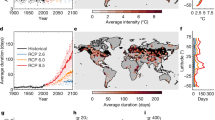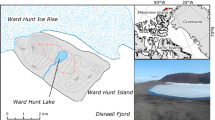Abstract
CLIMATE change, acid deposition and increasing solar ultraviolet irradiance1 have all combined to produce marked effects on lake waters and their ecosystems. Schindler et al.2 have shown that both climate warming and lake acidification have led to decreases in dissolved organic carbon concentrations in North American boreal lakes, resulting in a markedly increased exposure of the upper water column to solar ultraviolet radiation. Here we report ten years of observations of rainfall and lake chemistry at Swan Lake, Canada, that suggest that a fall in dissolved organic carbon concentrations can also occur by a different combination of climate change and acidification. In this boreal fresh water, a drought decreased lakewater levels, thus exposing to the atmosphere littoral sediments containing reduced sulphur from the previous atmospheric deposition of industrial sulphur dioxide into the lake and its catchment. This exposure caused a reoxidation of sediment sulphur, resulting in a remobilization of acid into the lake water, and thus a decrease in dissolved organic carbon concentrations sufficient to increase by three-fold the depth to which ultraviolet radiation can penetrate.
This is a preview of subscription content, access via your institution
Access options
Subscribe to this journal
Receive 51 print issues and online access
$199.00 per year
only $3.90 per issue
Buy this article
- Purchase on Springer Link
- Instant access to full article PDF
Prices may be subject to local taxes which are calculated during checkout
Similar content being viewed by others
References
Kerr, J. B. & McElroy, C. T. Science 262, 1032–1034 (1993).
Schindler, D. W., Jefferson Curtis, P., Parker, B. R. & Stainton, M. P. Nature 379, 705–708 (1996).
Keller, W. Can. J. Fish. Aquat. Sci. (Suppl. 1) 49, 3–7 (1992).
Dixit, S. S., Dixit, A. S. & Smol, J. P. Can. J. Fish, aquat Sci. 46, 1309–1312 (1989).
Dillon, P. J., Reid, R. A. & Girard, R. Wat. Air Soil Pollut. 31, 59–65 (1986).
Keller, W., Pitblaco, J. R. & Carbone, J. Can. J. Fish, aquat. Sci. (suppl. 1) 49, 25–32 (1992).
Vandermeulen, H., Jackson, M. B., Rodrigues, A. & Keller, W. Crypt. Bot. 3, 123–132 (1993).
Maclsaac, H. J., Keller, W., Hutchinson, T. C. & Yan, N. D. Wat. Air Soil Pollut. 31, 791–797 (1986).
Yan, N. D., Keller, W., Maclsaac, H. J. & McEachern, L. J. Ecol. Applic. 1, 52–65 (1991).
Keller, W. & Pitblado, J. R. Wat. Air. Soil Pollut. 29, 285–296 (1986).
Dillon, P. J. & LaZerte, B. D. Envir. Pollut. 77, 211–217 (1992).
Bayley, S. E., Behr, R. S. & Kelley, C. A. Wat. Air. Soil Pollut. 31, 104–114 (1986).
Bodo, B. & Dillon, P. J. in Time Series Analysis in Hydrology and Environmental Engineering (eds Hipel, K. W., McLeod, A. I., Panu, U. S. & Singh, V. P.) 285–298 (Kluwer, Boston, 1994).
Kelso, J. R. M., Shaw, M. A. & Jeffries, D. S. Envir. Pollut. 78, 65–71 (1992).
Schindler, D. W. et al. Proc. R. Soc. Edinb. 97B, 193–226 (1991).
Dillon, P. J., Reid, R. & de Grosbois, E. Nature 329, 45–48 (1987).
Effler, S. W., Schafran, G. C. & Driscoll, C. T. Can. J. Fish, aquat. Sci. 42, 1707–1711 (1985).
Schindler, D. W. et al. Hydrobiol. 229, 1–22 (1992).
Almer, B., Dickson, W., Ekström, C. & Hörnström, E. in Sulphur Pollution in the Aquatic Ecosystem (ed. Nriagu, J.) 271–311 (Wiley, New York, 1978).
Spry, D. J. & Wiener, J. G. Envir. Pollut. 71, 243–304 (1991).
Helmer, E. H., Urban, N. R. & Eisenreich, S. J. Biogeochemistry 9, 247–276 (1990).
Devito, K. J., Dillon, P. J. & LaZerte, B. D. Biogeochemistry 8, 185–204 (1989).
Scully, N. M. & Lean, D. R. S. Arch. Hydrobiol. Beih., Ergebn. Limnol. 45, 135–144 (1994).
Manabe, S. & Wetherald, R. T. Science 232, 626–628 (1986).
Husar, R. B., Sullivan, T. J. & Charles, D. F. in Acidic Deposition and Aquatic Ecosystems: Regional Case Studies (ed. Charles, D. F.) 65–82 (Springer, New York, 1991).
Jeffries, D. S., Lam, D. C. L., Wong, I. & Bloxam, R. M. Envir. Monitor. Assess. 23, 99–113 (1992).
Stolarski, R. S., Bloomfield, P., McPeters, R. D. & Herman, J. R. Geophys. Res. Lett. 18, 1015–1018 (1991).
Handbook of analytical methods for environmental samples (Lab. Services Branch Rep., Ontario Ministry of the Environment and Energy, Toronto, 1981).
Author information
Authors and Affiliations
Rights and permissions
About this article
Cite this article
Yan, N., Keller, W., Scully, N. et al. Increased UV-B penetration in a lake owing to drought-induced acidification. Nature 381, 141–143 (1996). https://doi.org/10.1038/381141a0
Received:
Accepted:
Issue Date:
DOI: https://doi.org/10.1038/381141a0
This article is cited by
-
Impacts of acid deposition and lake browning on long-term organic carbon storage in Canadian northern forest lakes
Journal of Paleolimnology (2024)
-
Water and sediment pollution of intensively used surface waters during a drought period — a case study in Central Northern Namibia
Environmental Monitoring and Assessment (2023)
-
Systematic Combination of Oligonucleotides and Synthetic Polymers for Advanced Therapeutic Applications
Macromolecular Research (2021)
-
Interconnection of bacterial and phytoplanktonic communities with hydrochemical parameters from ice and under-ice water in coastal zone of Lake Baikal
Scientific Reports (2020)
-
Carbon and nutrient cycling in kettle hole sediments depending on hydrological dynamics: a review
Hydrobiologia (2016)
Comments
By submitting a comment you agree to abide by our Terms and Community Guidelines. If you find something abusive or that does not comply with our terms or guidelines please flag it as inappropriate.



